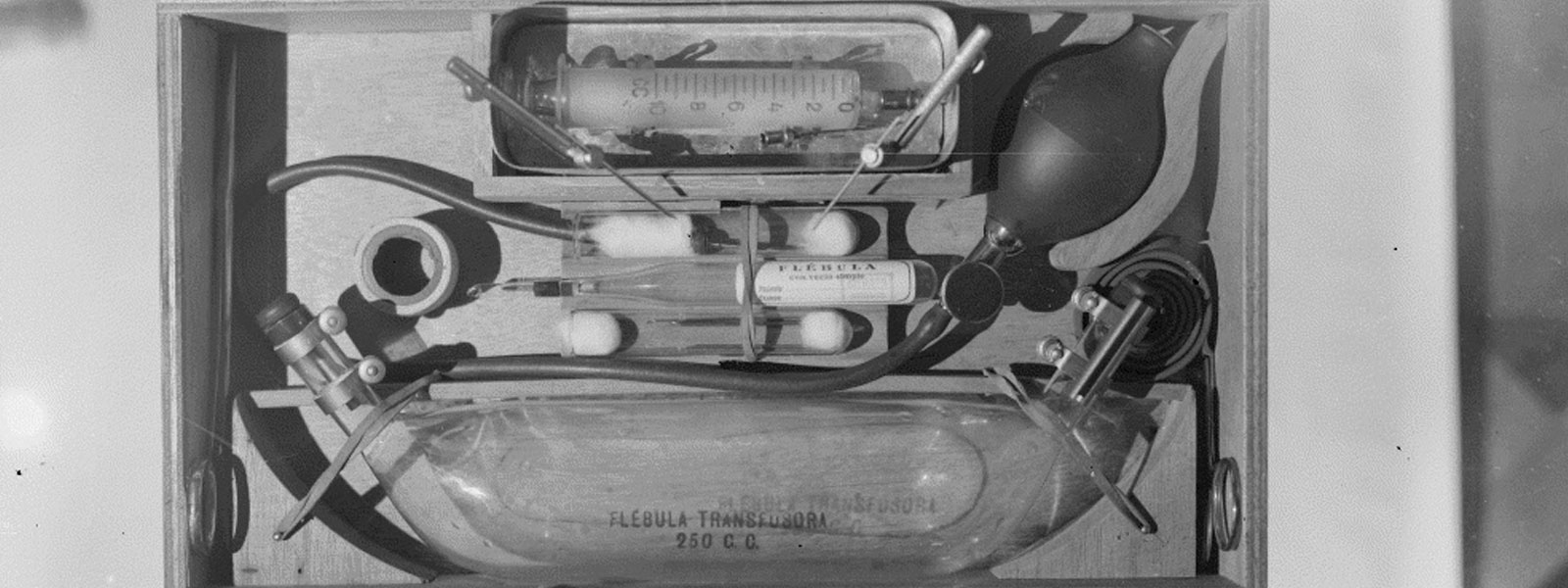Indirect transfusion
A better procedure to transfuse blood
Technical file
Type of innovation: Procedure
Scope: Hemotherapy
Innovation leader: Grifols i Roig, Josep Antoni
Year: 1928
Period: 1909-1971
Geographical scope: Spain
Economic impact: Medium
Level of innovation: Disruptive
Patent: Yes
Interdisciplinary connections: -
“Josep Antoni Grifols i Roig demonstrated for the first time in Spain that blood could be donated, stored and then transferred to a patient, without the donor and recipient both being present.”
Between the 1900s and 1950s, blood transfusions experienced a scientific revolution at a global level. Early blood transfusions were direct–in other words, performed arm-to-arm with both donor and recipient lying side by side, in the same room, at the same time. An indirect transfusion, where donations are made, the blood stored and later transfused into a patient, was clearly a more practical solution.
Achieving this without the risk of infection or contamination was the goal of several researchers, including Dr. Grifols i Roig. The chief consideration was developing an instrument that could facilitate the task.
A historic innovation
On May 23, 1928, Josep Antoni Grifols i Roig achieved that goal. He demonstrated for the first time in Spain that blood could be donated, stored and then transferred to a patient, without the donor and recipient both being present.
On that date, Grifols blood transfusion device was presented to the Barcelona Royal Academy of Medicine. By building on the work of other scientists, Josep Antoni had perfected the aseptic system.
His instrument was capable of storing blood without it coagulating: first with the use of paraffin, and then with sodium citrate. Consequently, he was also the first to perform indirect transfusions under sterile conditions in Spain. It was a practically risk-free method, since the body metabolizes sodium citrate immediately. His contribution was part of the evolutionary story of blood transfusion. Others are listed below.

Landmarks leading to indirect transfusion
| 1818 | James Blundell conducts the first direct transfusion between humans successfully. |
| 1881 | Berlin surgeon Albert Landerer uses saline serum for the first time to replace blood lost during operations. |
| 1900 | Karl Landsteiner develops the first classification of blood groups into A, B and C (which later would become group O). |
| 1902 | Alfred Decastello and Adriano Sturli add the AB group. |
| 1906 | George Washington Crile makes direct transfusions with his artery-venous method, which takes into account Landsteiner's findings. |
| 1907 | Ludvig Hektoen suggests for the first time that donors and patients should be compatible. |
| 1912 | Roger Lee demonstrates that group O is a universal donor and that group AB is a universal recipient. |
| 1913 | A.R. Kimpton and J.H. Brown initiate indirect transfusion by conserving blood in their paraffinized tubes. |
| 1914 | A. Hustin and L. Agote observe, independently, the anticoagulant effect of sodium citrate, which made the transfusion of preserved blood possible. |
Bibliography
Grifols-Roig, J.A. (1933). La transfusió de sang citratada per mitjà de la flèbula transfusora. Annals de l'Hospital Comarcal de Vilafranca del Penedès, 49-65.
Grifols-Roig, J.A. (1934). Tècnica actual i probablement definitiva de la transfusió sanguínia per mitjà de la Flèbula transfusora. Annals de Medicina, 4, 712-714.
Peset Llorca, V. (1943). La transfusión de sangre (biología y técnica). Barcelona: Editorial Científico Médica.
Machetti Croso, S. (1952). Epítome de Transfusión Sanguínea. Zaragoza: Artes gráficas Pirineos.
Starr, D. (1998). Blood: An Epic History of Medicine and Commerce. New York: Alfred A. Knopf, Inc.
Schneider, W.H. (2003). Blood transfusion between the wars. Journal of the History of Medicine and Allied Sciences, 58(2), 187-224.
Grifols-Lucas, V. (2009). Amb un suro i un cordill. Vivències d'un empresari de postguerra. Barcelona: Grupo Grifols, S.A.
Related innovations
INSTRUMENT
Transfusion flebula